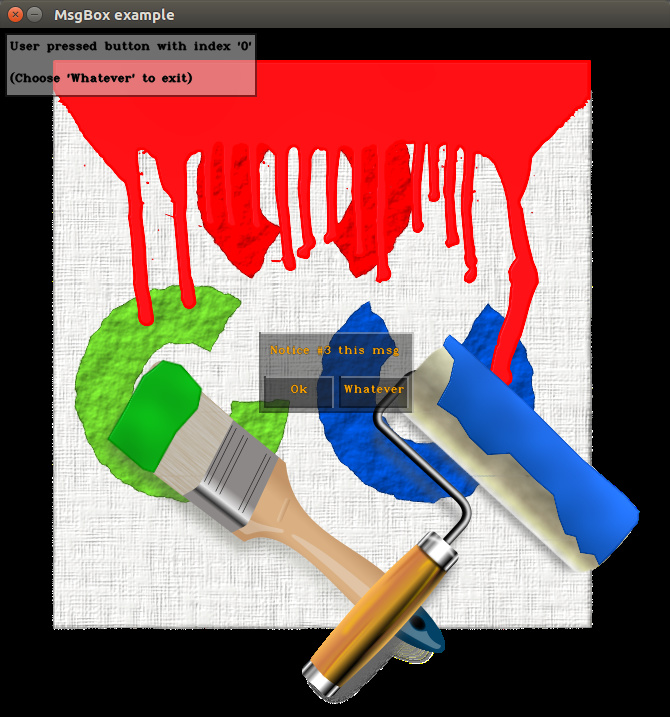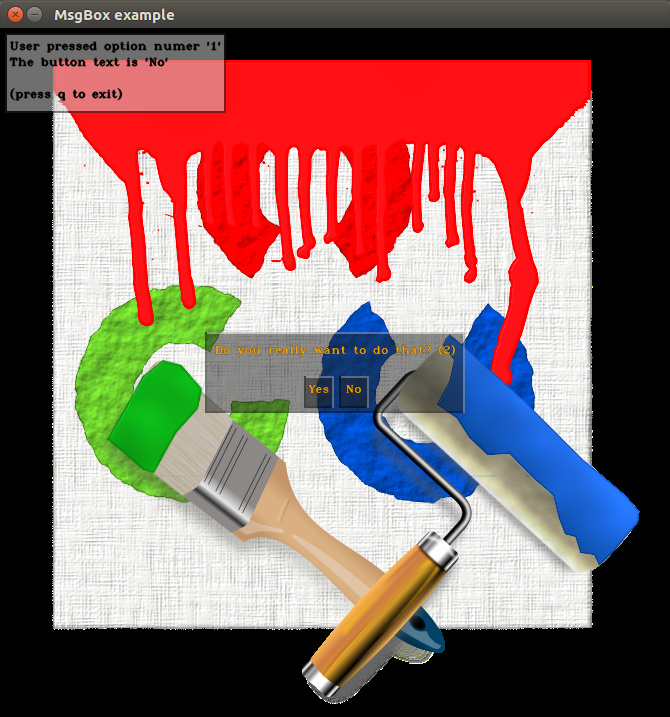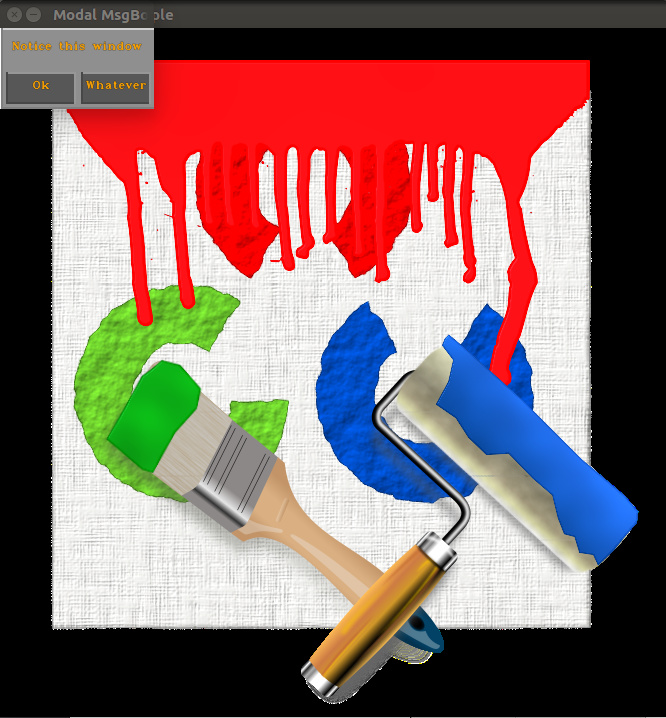Table of Contents
The canvascv::MsgBox is a little different from other widgets, because it is very high level.
This makes it easy to use and a good starting example for widgets that get mouse input.
The MsgBox is a "one shot user pressed and widget died" kind of widget.
Remember the main loop
Just to remind you from the previous tutotial, the main loop looks something like this:
We want to work on top of an existing image so you can see the transparency.
Let's add the real code now.
A simple modal MsgBox
Since a MsgBox usually requires immediate user attention, you have a way to block other GUI while waiting for a user reaction.
Remeber that the MsgBox is a "one shot user pressed and widget died" kind of widget. Here we're recreating the MsgBox each time it dies.
By default a MsgBox will be placed at the center of the screen.
You can poll it at each loop with canvascv::MsgBox::getUserSelection() or you can use it in a modal way, in which you block everything else and wait on that line of code for the user selection.
This is what we'll do here, with this code:
Notes:
- We needed canvascv::Canvas::setMouseCallback() since the Canvas will intercept mouse events for the MsgBox now.
- All widgets have a static create methods, which is the only way to create them.
- The canvascv::MsgBox::create() will return a shared_ptr<MsgBox> instance, which you don't have to keep since another one is kept by the canvascv::Layout.
- Here we're using canvascv::MsgBox::getUserSelection(true) immediatly on that shared_ptr, and by passing true we're blocked at that line of code.
- CCV_STR lets you create a string as you would write into a stream.
- When executed with a path to an image, this gives you (depends on your image):

A non modal MsgBox
Remeber that the MsgBox is a "one shot user pressed and widget died" kind of widget. Here we're recreating the MsgBox each time it dies, but with callbacks.
If you wan to see code also using the MsgBox without callback (polling) then see example_msgbox.cpp.
Here we'll be working with callbacks. The callback is called when the user presses a button.
After the callback is called the MsgBox will be destroyed automatically by the framework.
In our callback we'll immediatly create a new MsgBox with the same callback, just changing the message.
Add these lines to the 'main loop reminder code' above, after creating the namedWindow():
Notes:
- All widgets have a static create methods, which is the only way to create them.
- The canvascv::MsgBox::create() will return a shared_ptr<MsgBox> instance, which you don't have to keep since another one is kept by the canvascv::Layout.
- This tutorial is using C++11 lambda expressions as callbacks, but anything which has the "void(Widget*,int)" signature will work.
- We needed canvascv::Canvas::setMouseCallback() since the Canvas will intercept mouse events for the MsgBox now.
- CCV_STR lets you create a string as you would write into a stream.
- When executed with a path to an image, this gives you (depends on your image):

An external window modal MsgBox
Since a MsgBox usually requires immediate user attention, you have another way to block other GUI while waiting for a user reaction.
This API opens an new independent OpenCV window, occupying just the MsgBox, and waiting for a user response.
This is a blocking API, the code will wait for a user button press.
(You actually saw something like this when we explained the canvascv::Canvas::fatal() in a previous tutorial)
Notes:
- Again - this is a blocking API. The line which is using canvascv::MsgBox::createModal() waits for a response.
- Currently there is no control of where the OpenCV window will be opened.
- CCV_STR lets you create a string as you would write into a stream.
- When executed with a path to an image, this gives you (depends on your image):

That's all for this tutorial
Generated by
 1.8.11
1.8.11


 Facebook
Facebook
 Linkedin
Linkedin
 Google+
Google+